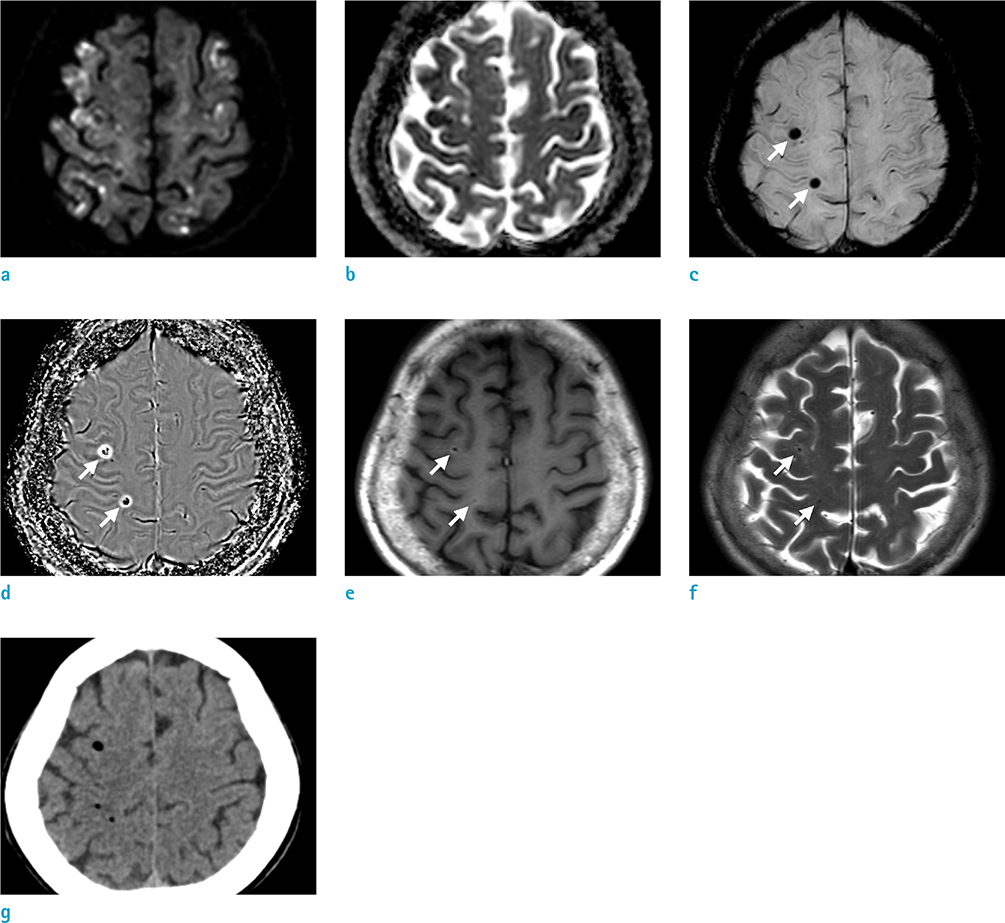Investig Magn Reson Imaging.
2019 Mar;23(1):70-74. 10.13104/imri.2019.23.1.70.
Cerebral Air Embolism: a Case Report with an Emphasis of its Pathophysiology and MRI Findings
- Affiliations
-
- 1Department of Radiology, Wonkwang University Hospital, Jeonlabuk-do, Korea. sschoi@wonkwang.ac.kr
- KMID: 2442236
- DOI: http://doi.org/10.13104/imri.2019.23.1.70
Abstract
- Cerebral air embolism (CAE) is a rare complication of various medical procedures. It manifests with symptoms similar to those of typical acute cerebral infarction, however the treatment is quite different. We present a case of arterial CAE that was associated with a disconnected central venous catheter and appeared as punctate dark signal intensities with aliasing artifacts on the susceptibility-weighted filtered phase magnetic resonance image. The susceptibility-weighted filtered phase image can be helpful for diagnosing CAE and the magnetic resonance imaging reflects the pathophysiology of CAE.
MeSH Terms
Figure
Reference
-
1. Jain KK. Textbook of hyperbaric medicine. 6th ed. Switzerland: Springer;2017. p. 121–129.2. Mishra R, Reddy P, Khaja M. Fatal cerebral air embolism: a case series and literature review. Case Rep Crit Care. 2016; 2016:3425321.
Article3. Bauerle J, Fischer A, Hornig T, Egger K, Wengenmayer T, Bardutzky J. Therapeutic hypothermia in cerebral air embolism: a case report. Springerplus. 2013; 2:411.
Article4. Lin C, Barrio GA, Hurwitz LM, Kranz PG. Cerebral air embolism from angioinvasive cavitary aspergillosis. Case Rep Neurol Med. 2014; 2014:406106.
Article5. Suri V, Gupta R, Sharma G, Suri K. An unusual cause of ischemic stroke - Cerebral air embolism. Ann Indian Acad Neurol. 2014; 17:89–91.
Article6. Togo M, Hoshi T, Matsuoka R, Imai Y, Kohara N. Multiple small hemorrhagic infarcts in cerebral air embolism: a case report. BMC Res Notes. 2017; 10:599.
Article7. Caulfield AF, Lansberg MG, Marks MP, Albers GW, Wijman CA. MRI characteristics of cerebral air embolism from a venous source. Neurology. 2006; 66:945–946.
Article8. Kaichi Y, Kakeda S, Korogi Y, et al. Changes over time in intracranial air in patients with cerebral air embolism: radiological study in two cases. Case Rep Neurol Med. 2015; 2015:491017.
Article9. Hwang Y, Kim YJ. Retrograde cerebral venous air embolism on susceptibility-weighted imaging. Can J Neurol Sci. 2018; 45:464–465.
Article10. Han SS, Kim SS, Hong HP, Lee SY, Lee SJ, Lee BK. Massive paradoxical air embolism in brain occurring after central venous catheterization: a case report. J Korean Med Sci. 2010; 25:1536–1538.
Article
- Full Text Links
- Actions
-
Cited
- CITED
-
- Close
- Share
- Similar articles
-
- Cerebral Air Embolism Following a Gastroscopy
- Gradient-Echo MRI in Defining the Severity of Cerebral Fat Embolism
- Cerebral Air Embolism in a Patient with a Tuberculous-Destroyed Lung during Commercial Air Travel: A Case Report
- Stroke Caused by Cerebral Air Embolism after Central Venous Catheter Removal: A Case Report
- Systemic Air Embolism after CT-guided Transthoracic Needle Biopsy



